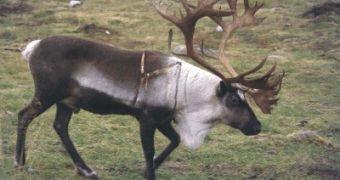Do you know what's the similarity between Rudolf and those kilted Scots?
They use a bagpipe to impress the females.
A group of European biologists from Berliner Leibniz Institute of Zoo and Wildlife Research in Germany, Ilomantsi Game Research Station in Finland and the University of Veterinary Medicine in Vienna, have found that the male reindeer's large air sac, influencing emitted vocal sounds, is a key factor of his masculinity and reproductive success, as the throaty mating call can signal of his fighting ability to rival males.
Like in other polygamous (harem-like mating system) species, the voice organs of reindeer differ according to gender.
The inflated air sac also expands the neck contour, making the male look bigger.
The hoarse rattling sound, or rutting call, with its head kept low (by contrast, male red deer are renowned for roaring with the head elevated) combined to optical signaling can impress off rival males as it is an indicator of the caller's fighting ability, prevent fighting, allowing the male reindeer conserve energy.
At the same time, the call serves to attract female mating partners.
Adult males have a much larger air sac than females and the young.
In early life, the development of the air sac is comparable in male and female reindeer until they reach the age of two or three years, when the female's air sac ceases the growth, while the male's continues to develop.
Males vocalize almost exclusively during the autumn mating season, whereas females are very silent during that time.
Females usually employ vocal communications mainly with their young, in the first months after the birth in summer.
In mother-young communication, the air sac permits the mother to emit individualized calls and this way contributes to individual recognition.
The results were published in the Journal of Anatomy.

 14 DAY TRIAL //
14 DAY TRIAL //